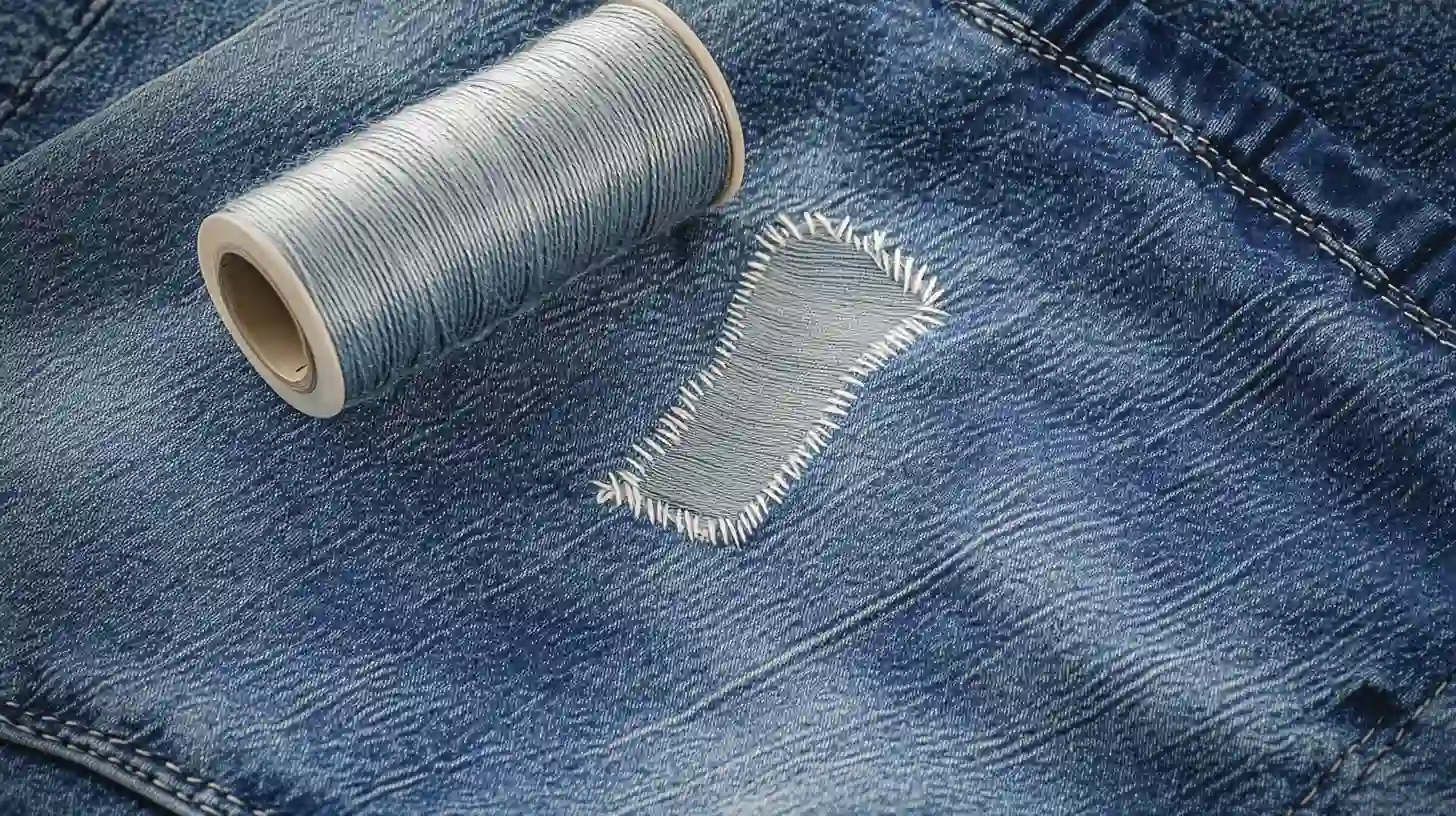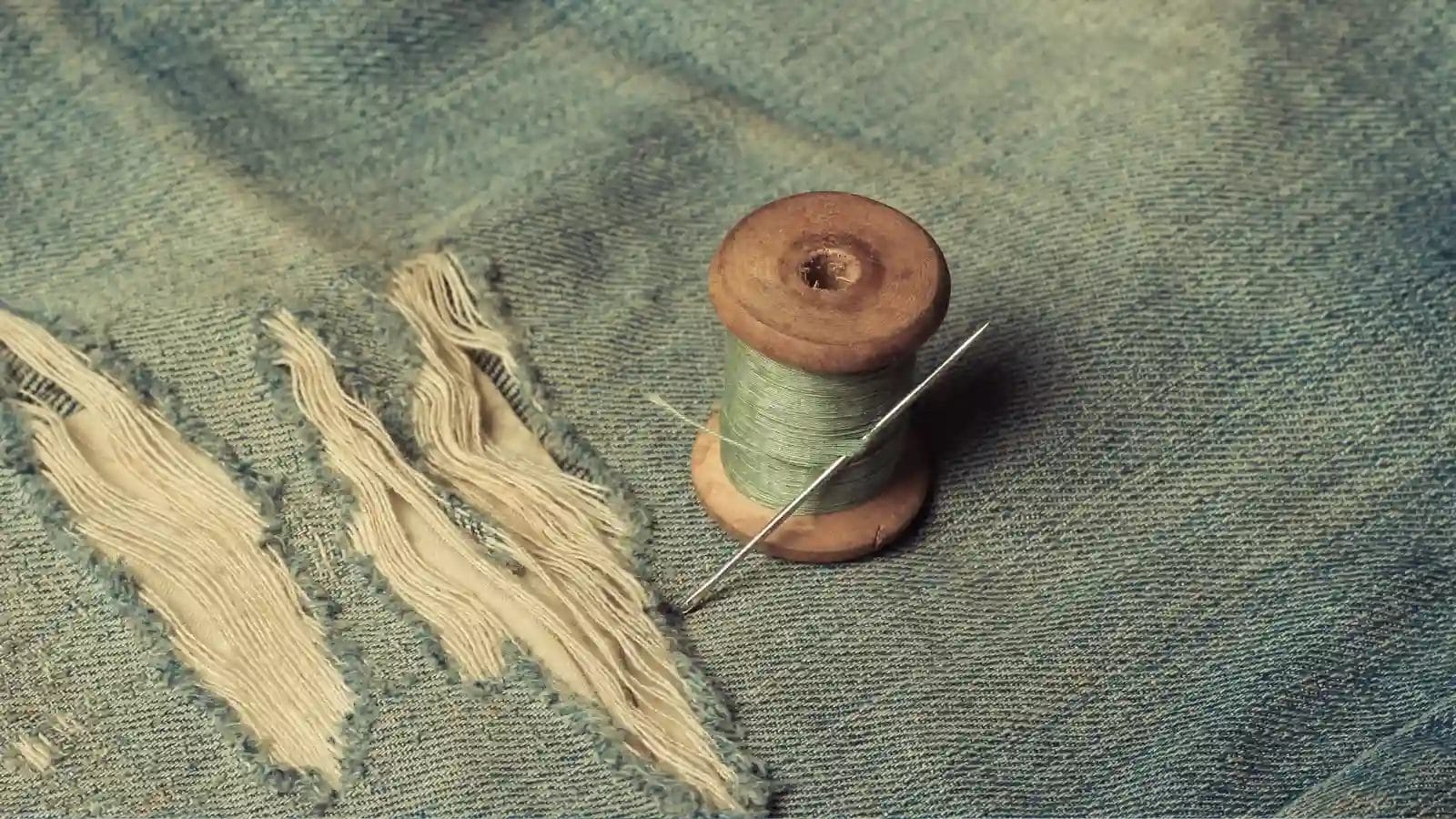Are you ready to elevate your sewing skills and unleash your creativity? Sewing with denim is not just a practical choice. It’s an exciting adventure that allows you to craft stylish, durable pieces that stand the test of time.
Whether you want to upcycle old jeans, create a trendy jacket, or design unique accessories, denim offers endless possibilities. With the proper techniques and a little bit of inspiration, you can transform this sturdy fabric into masterpieces.
Let’s dive into denim sewing and discover the joy of bringing your ideas to life!
Key Takeaways
- To handle denim's thickness, use heavy-duty needles (size 90/14 or 100/16) and strong polyester thread.
- Pre-wash and dry denim to prevent shrinkage and color bleeding before sewing.
- Adjust sewing machine tension and stitch length to avoid puckering and achieve smooth seams.
- Use a walking foot and hump jumper to manage thick seams and multiple layers effectively.
- Reinforce high-stress areas with flat-felled seams and bar tacks for added durability.
Understanding Denim Fabric

To sew with denim, you need to understand its common types and characteristics.
Common Types of Denim
Denim is a yarn-dyed twill weave fabric. It offers a unique blend of durability and style, making it a staple in many wardrobes.
- Raw Denim: Unwashed, untreated, and stiff. Develops unique fades over time with wear.
- Selvedge Denim: Edges finished with a self-edge, often has a tighter weave and higher quality.
- Stretch Denim: Contains elastane, making it more flexible and comfortable.
- Crushed Denim: Has a permanently wrinkled appearance, offering a distinctive texture.
- Acid-Wash Denim: Treated with chlorine to create a mottled, faded look.
- Organic Denim: Made from organically grown cotton, eco-friendly and sustainable.
- Recycled Denim: Made from repurposed denim fabrics, promoting sustainability.
- Waxed Denim: Coated with a wax finish for a glossy, water-resistant surface.
Characteristics of Denim
Understanding the characteristics of denim can elevate your sewing projects to a new level.
- Durable: Known for its robustness, denim is resistant to wear and tear.
- Comfortable: Over time, it softens and molds to the body.
- Versatile: Suitable for various clothing items such as jeans, jackets, and skirts.
- Breathable: Allows air circulation, making it comfortable in different climates.
- Heavyweight: The fabric has a substantial feel, contributing to its durability.
- Stretch Options: Available in stretch variants for added comfort and flexibility.
How to Sew With Denim: Tips for Sewing Denim

Here's a guide to sewing with denim. Follow these practical sewing tips carefully to ensure the success of your finished project.
1. Pre-wash and Dry denim
Before diving into your denim sewing project, it's crucial to pre-wash and dry your fabric to prevent any unwelcome surprises later.
Pre-wash the denim separately in warm water to avoid bleeding and shrinkage.
After washing, dry it on regular settings, then iron the damp denim using a medium-hot setting and steam.
This ensures smooth, crease-free fabric ready for sewing.
2. Ensure Clean Cuts
To achieve clean, precise cuts in your denim sewing project, you'll need the right tools.
Use sharp shears designed for denim to ensure clean edges. For heavyweight denim, lay it flat before cutting to prevent distortion.
For intricate sewing patterns, a rotary cutter and cutting mat provide greater control.
3. Mark the Fabric
Use a sharp, water-soluble chalk pencil to make precise pattern markings on your denim.
Always mark the fabric on the wrong side to avoid visible marks. Ensure you double-check the grainline and pattern alignment while marking.
Skip traditional fabric markers that may bleed or stain.
For lightweight denim, use pins to secure patterns; for heavyweight, cut flat to maintain accuracy.
4. Interfacing
When sewing with denim, interfacing adds structure and support to waistbands, cuffs, and button plackets.
Opt for a lightweight fusible interfacing for medium-weight denim. Always pre-wash interfacing along with the denim to avoid shrinkage issues.
Use a pressing cloth to apply interfacing with a hot iron and steam, ensuring a professional finish without bubbles or wrinkles.
5. Needles and Thread
Selecting the right needles and thread is crucial when sewing jeans, jackets, or skirts.
Use a heavy-duty jeans needle, size 90/14 for lighter denim and 100/16 for heavyweight.
Opt for all-purpose polyester thread for seams and heavy-duty thread for topstitching.
This ensures your denim projects are both durable and professional-looking.
6. Stitch Length and Tension
To achieve flawless seams in your denim projects, you need to consider stitch length and tension.
Use a longer stitch length, around 3.0 to 3.5 mm, to avoid puckering. Adjust the thread tension slightly tighter for bulky seams.
For topstitching thread, increase the stitch length to 4.0 mm or more for a professional look.
Always test settings on scrap denim first.
7. Reinforce Seams
After adjusting stitch length and tension, it's time to focus on reinforcing seams for your denim project.
Use a flat-felled seam for strength, especially in high-stress areas. Topstitch with heavy-duty thread for added durability and style.
Reinforce pocket corners and belt loops with bar tacks to prevent tearing. This will ensure your denim piece lasts longer.
8. Handle Thick Seams and Layers
Navigating thick seams and layers is a common challenge when sewing with denim.
Use the correct presser foot, like a walking foot, to keep your fabric aligned and prevent stretching. A hump jumper helps you smoothly sew over bulky seams.
Secure multiple layers of fabric with pins or clips, and iron seams flat for a polished finish.
9. Hems and Finishes
When it comes to hemming and finishing denim, achieving a clean, professional look is crucial.
Use a 3/4 double fold hem to manage bulky seams. A flat felled seam provides strength and prevents fraying.
Pressing hems ensures crisp edges and easier sewing.
10. Pressing Tips
Pressing denim properly can make a significant difference in the final appearance of your project.
Use a high-temperature cotton setting with steam to smooth out any creases. To handle bulky seams, press them flat and then apply a clapper to set the crispness.
Always press denim while it's damp for the best results, ensuring a professional, polished finish.
Common Sewing Projects with Denim

Denim's versatility makes it a favorite fabric for a variety of sewing projects, from denim garments to stylish statement pieces.
- Jeans Repair: Patch holes, reinforce weak spots, and re-hem worn-out jeans.
- Denim Tote Bags: Create sturdy and stylish bags perfect for daily use.
- Denim Skirts: Repurpose old jeans into fashionable skirts.
- Denim Quilts: Use old denim pieces to craft durable and cozy quilts.
- Aprons: Make heavy-duty aprons ideal for cooking or crafting.
- Pillow Covers: Sew decorative pillow covers for a rustic, chic look.
- Denim Jackets: Customize with patches, embroidery, or fabric paint.
- Coasters and Placemats: Craft functional and trendy table accessories.
- Headbands and Hair Accessories: Create stylish denim hairpieces.
- Denim Baskets: Make storage baskets to organize household items.
Tips and Tricks for Working with Denim
When working with denim, it's crucial to manage fraying edges, avoid needle breakage, and regularly maintain your sewing machine.
Manage Fraying Edges
While sewing with denim, managing fraying edges is crucial to achieving a clean and durable finish.
Use a serger or zigzag stitch to prevent fraying. Employing a flat-felled seam can encase raw edges, offering a professional look.
Pinking shears are another great tool. Their zigzag pattern reduces fraying. For extra protection, use fray check liquid on cut edges before sewing.
Avoid Needle Breakage
After managing fraying edges effectively, the next is to ensure your sewing process avoids needle breakage.
Start by using a jeans needle and adjusting thread tension to prevent strain. Use heavy-duty thread for strength, and consider using a walking foot to keep layers aligned.
Avoid backstitching on topstitching to reduce stress on the needle and ensure smooth sewing.
Maintain Your Sewing Machine
Maintaining your sewing machine is crucial for a smooth sewing experience, especially when working with denim.
Regularly clean the feed dogs, needle plate, and bobbin area to remove lint. Use a jeans needle size 90/14 or 100/16 for better stitch quality.
Adjust the thread tension to avoid puckering. A walking foot helps feed layers evenly.
Test settings on scrap denim first.
Conclusion
Sewing with denim may seem daunting, but with the right preparation and tools, you can achieve professional results. Remember to pre-wash the fabric, use sharp tools, and adjust your machine's tension. Reinforce high-stress areas for added durability.
By following these guidelines, you'll create polished and long-lasting denim projects. So, gather your materials, prep your machine, and dive into your next denim adventure with confidence. Happy sewing!
Learn more sewing tips on the Longan Craft Blog, and dive into the fabric world with Longancraft!
FAQs
Can I Sew Denim on a Regular Sewing Machine?
Yes, you can sew denim on a regular sewing machine. Use a jeans needle (90/14 or 100/16) and adjust the thread tension. Lightweight and medium-weight denim work best, but take your time with thicker fabrics.
Is Denim Difficult to Sew?
Yes, denim can be difficult to sew due to its thickness and rigidity. You'll need specialized needles, proper thread tension, and possibly a walking foot. Practice and patience are key, but you can master it with time.
What Stitch Is Best for Denim?
For denim, you'll want to use a straight stitch, as it provides strong and durable seams. In stress areas, try a flat-felled seam to prevent fraying. Adjust your machine's tension to avoid puckering or weak seams.
Do I Need Special Thread to Sew Denim?
Yes, you do need a special thread for sewing denim. Use all-purpose polyester thread for construction seams and heavy-duty thread for topstitching. This ensures strength, flexibility, and a defined finish, enhancing your garment's overall durability and appearance.


0 comments